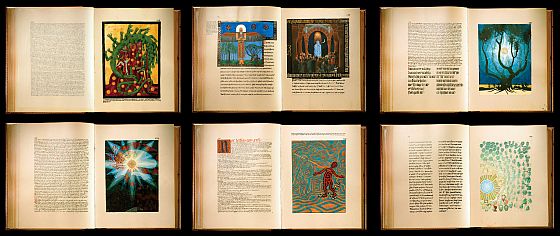
Pages from The Red Book
Damien Walter writes: Between the years of 1914 and 1930 the psychiatrist and founder of analytical psychology Carl Gustav Jung undertook what he later termed a ‘voluntary confrontation with his unconscious’. Employing certain techniques of active imagination that became part of his theory of human development, Jung incited visions, dreams and other manifestations of his imagination, which he recorded in writing and pictures. For some years, he kept the results of this process secret, though he described them to close friends and family as the most important work of his life. Late in his career, he set about collecting and transcribing these dreams and visions.
The product was the ‘Liber Novus’ or ‘New Book’, now known simply as The Red Book. Despite requests for access from some of the leading thinkers and intellectuals of the 20th century, very few people outside of Jung’s close family were allowed to see it before its eventual publication in 2009. It has since been recognised as one of the great creative acts of the century, a magnificent and visionary illuminated manuscript equal to the works of William Blake.
It is from his work on The Red Book that all of Jung’s theories on archetypes, individuation and the collective unconscious stem. Of course, Jung is far from alone in esteeming human creativity. The creative capacity is central to the developmental psychology of Jean Piaget and the constructivist theory of learning, and creativity is increasingly at the heart of our models of economic growth and development. But Jung provides the most satisfying explanation I know for why the people I worked with got so much out of discovering their own creativity, and why happiness and the freedom to create are so closely linked.
Jung dedicated his life to understanding human growth, and the importance of creativity to that process. It seems fitting that the intense process that led to the The Red Book should also have been integral to Jung’s own personal development. Already well into his adult life, he had yet to make the conceptual breakthroughs that would become the core of his model of human psychology. In quite a literal sense, the process of creating The Red Book was also the process of creating Carl Jung. This simple idea, that creativity is central to our ongoing growth as human beings, opens up a very distinctive understanding of what it means to make something. [Continue reading…]

